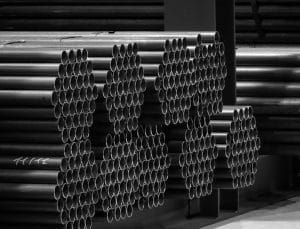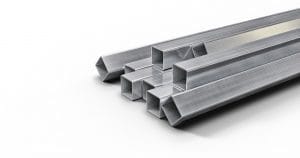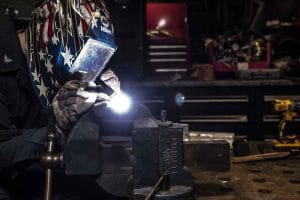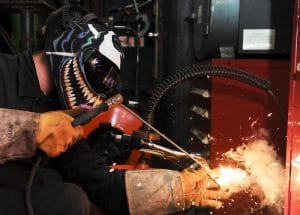Gas welding is also known as oxy welding, oxy-fuel welding, or oxy-acetylene welding.
Gas welding is a process in which the material which needs to be welded is heated up to its melting temperature with the help of high-temperature flames. Oxy-fuel gas torch generally known as a welding torch.
Welding of metal results when two pieces are heated to a temperature that produces a shared pool of molten metal. The molten pool is generally supplied with additional metal called a filler.
Filler material selection depends upon the metals to be welded, they are generally bare or lightly coated with flux.
It consists of two cylinders: oxygen and acetylene cylinder, oxygen cylinder is denoted as blue or black in color whereas acetylene cylinder is denoted with red color.
Note:
- The valves of oxygen cylinders are made up of brass whereas in acetylene cylinder valves are made of Steel, brass valves do not corrode easily this is why brass is used in an oxygen cylinder.
- Acetylene is a very dangerous gas because it can explode under its own weight, so to prevent this calcium silicate is filled in the cylinder and then acetone is poured.
The purpose of acetone is to absorb acetylene. The absorbing capacity of acetone increases by increasing pressure, so the pressure of the acetylene cylinder is higher.
Note:
Valves of acetylene cylinders are made up of stainless steel because acetylene can easily react with copper and form copper-acetylene which is highly explosive in nature.
Types of Oxy/Gas welding | Flames and their Temperature range
There are three types of flames based on the basis of their temperature range and application.
The welder can adjust the flames by controlling the proportion of fuel with oxygen.
Difference between Neutral, Carburizing, and Oxidizing flame

1- Neutral Flame

- In neutral flame the ratio of Oxygen and acetylene is 1 to 1 by volume, neutral flame produces hissing sound and the flame is used to weld materials like-
- Low carbon steel
- Aluminium
- Mild Steel
- Copper
- Cast Iron
- The film consists of two parts: the inner core and the outer envelope, the outer envelope is generally used to preheat the material and the actual heat for melting the metal is generated by using the inner core flame.
- The inner core is white in colour and the outer envelope is blue in colour
- The temperature of the neutral flame is-
- Inner core- 3150°C / 5702°F / 3423K
- Outer Envelope- 1270°C / 2318°F / 1543K
- It has a luminous hissing cone which indicates that the combustion is complete.
2- Carburizing flame

- In carburizing flame the ratio of acetylene or fuel gas is more as compared to oxygen.
- Carburizing flame contains unburnt carbon after solidification of the weld due to which weld bead will have pitted surface over it and the weld will appear to be very hard and brittle. This happens due to the presence of large free carbon particles in the flame.
- It is used to weld materials like-
- High Carbon steel
- Cast iron
- Lead
- Aluminium alloys
- Does not produce any hissing sound because it contains a large number of unburnt carbon particles and its temperature is lower than neutral and oxidizing flame.
Note:
If excess unburnt carbon finds its way to the molten weld puddle, it appears to be boiling.
- The inner core is white in color, an intermediate flame is in red color and the outer envelope is blue in color.
- The temperature of the neutral flame is-
- Inner core- 2900°C / 5252°F / 3173K
- Intermediate core- 2000°C
- Outer core-1300°C
3- Oxidizing flame

- In Oxidizing flame, the ratio of oxygen is more as compared to fuel gas.
- Oxidizing flames are the hottest flames as compared to a neutral and carburizing flame, the flame consists of a very short pointed white inner core and a shorter blue flame envelope.
- The inner length of a core is reduced, which shows that there is an excess supply of oxygen.
- The oxidizing flame is used to weld materials like-
- Alloys of copper and zinc
- Manganese steel
- Bronze
- Brass
- Oxidizing flame produces a roaring sound.
- The temperature of the neutral flame is-
- Inner core- 3300°C / 5972°F / 3573K
Oxy/Gas welding equipments
1- Gas hoses
- Gas hoses are used to transfer the gases used for the welding operation.
- Generally, for gas welding operation a double-hose or twined design hoses are used, which means that the Oxygen and fuel hoses will be joined together side by side.
If in case separate hoses are used it is generally advised to clip them together at intervals approximately around 3 feet (1 meter) apart.
- The color codes of hoses vary from country to country.
- For the United States, the oxygen hose is green and the fuel hose is red.
- For the United Kingdom and other countries, the oxygen hose is blue or black in color, and the fuel hose is red.
Note:
If liquefied fuel is used such as LPG or propane then the color of the fuel hose should be orange.
It is not suggested to use twin design hoses or to keep both hoses together during gas cutting operation because while gas cutting operation there are chances that the beads of molten metals can blow off and can be lodged between the hoses where they can cause a burn and damage hose pipe.
2- Pressure regulators

- The function of a pressure regulator is to ensure that the required pressure should reach the welding torch, once the required pressure is reached the welder adjusts the flow rate by using needle valves present on the torch.
- Generally, most pressure regulators have two stages of regulators. The first stage is a fixed pressure regulator which releases the gas from the cylinder at constant intermediate pressure, despite the reason that the pressure in the cylinder is falling as gas is continuously consumed for welding.
- The second stage of pressure regulator controls the pressure reduction from the intermediate pressure to the low outlet pressure (remaining pressure).
- There are two pressure gauges present on the regulator where one indicates the cylinder pressure and the other indicates the pressure on the hose.
3- Non-return valve
- Acetylene is a highly flammable and explosive gas so we have to make sure that during gas welding operation the frame should not backflow to the cylinder.
- To prevent gas from backflow a flashback arrestor/non-return valve is used, which is placed between the hose and welding torch on both Oxygen and fuel lines.
4- Check Valve
- The check valve allows the gas to flow in one direction, it usually consists of a chamber containing a ball pressed against the one end of a chamber by a spring.
- When we open the valve of a welding torch the ball is pressed against the spring due to the motion of the gas. As soon as we stop the torch it automatically closes the valve by releasing the spring, this way the gas does not flow in the opposite direction.
5- Welding torch

The welding torch is the most essential part of gas welding by the help of which the builder manipulates the quantity of fuel and oxygen to generate different gas flames as per the requirement and application of the weld.
6- Welding electrodes
In gas welding generally, bare coated or lightly coated electrodes are used, the function of these electrodes is to provide excess material for the weld, protect the weld against the formation of oxides and nitrides, or any other inclusions.
Note:
The light coating on the surface of electrodes is applied by a process of spraying, washing, dipping, brushing, tumbling, or wiping.
7- Oxygen and fuel cylinders
- Gas welding consists of two cylinders, one is for oxygen and another is for fuel, where the oxygen cylinder with brass valves is black in color and the acetylene cylinder with steel valves is red in color.
- Generally, the most common fuel used in oxy welding is acetylene but there are many other gases used as an alternative to acetylene which are propylene, liquid petroleum gas (LPG), propane, natural gas, hydrogen, MAPP (Methylacetylene-propadiene gas).
Note:
Pressure of acetylene is about 1700kPa (250 psi) in the tank when full.
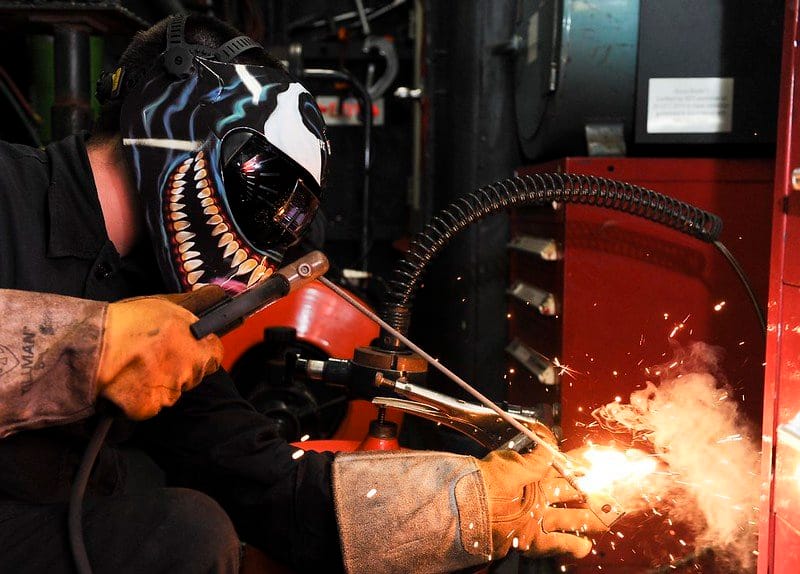
Welding Overview | Select the best type of Welding for use
How to set different flames in Gas welding
1- How to set Neutral flame
- First, slowly open the valve of the oxygen cylinder and then the acetylene cylinder, adjust the regulator screw for proper pressure settings.
- Ignite the welding torch after you open the acetylene valve to a quarter turn and then slowly adjust the pressure until you see two/three different colors of flames.
- You will see a feather-shaped inner core and outer blue envelope, then continue to slowly open the oxygen valve until the feather disappears.
- Finally, a neutral flame is achieved with a hissing sound.
2- How to set a Carburizing flame
- To create a carburizing flame you slowly need to open the valve of the acetylene cylinder until the length of the feather reaches two to three times the length of the inner core.
- The carburizing flame does not produce any sound as compared to an oxidizing and neutral flame.
3- How to create a Oxidizing flame
- To create an oxidizing flame you slowly need to open the valve of the oxygen cylinder until the length of the inner core reduces to its quarter length with a roaring sound.
Advantages and disadvantages of Oxy/Gas welding
Advantages:
- All ferrous and non-ferrous materials can be welded except brass.
- Do not require electricity for its operation.
- Better control over the temperature.
- Suitable for welding dissimilar materials.
- A high depth of cut can be obtained by the gas cutting process.
- The gas welding setup is easily portable.
- Used excessively in the jewelry making industry.
- Low maintenance cost.
Disadvantages:
- The cost of acetylene is very high if compared to other gaseous fuels.
- The finish of the final weld achieved is not very high.
- Less working temperature of gas flame.
- Can not be used for heavy sections.
- Safety problems in terms of storage and handling gases.
- The heat affected area is more as compared to other welding processes.
When to use Gas welding (Gas welding applications)
- Used for joining and cutting all types of ferrous and nonferrous metals except brass.
- To work with platinum metal as platinum can be only used by oxyhydrogen flame.
- Used in automotive repairs, removing a seized bolt.
- In the making of jewelry where an oxyhydrogen torch is used whose gas supply is generated immediately by electrolysis of water.
- In the glass industry for fire polishing.
- For heating metals in automotive and other industries.
What is Gas Cutting
For gas cutting operation metal is heated to a temperature at which rapid oxidation of material takes place this temperature is also known as kindling temperature.
In gas cutting operation there are generally three pipes attached to the torch, whereas in gas welding operation only two pipes are attached.
Three pipes used in gas cutting operation consist of fuel pipe, oxygen pipe, and the third pipe which is present in gas cutting and not present in gas welding is excess oxygen pipe.
The work of excess oxygen pipe is to increase the flow of oxygen in the desired direction by which metal oxidation takes place and blows away oxidized metal out of the way and creates a deep cutting groove.





